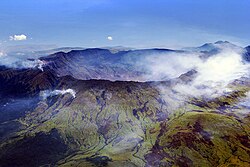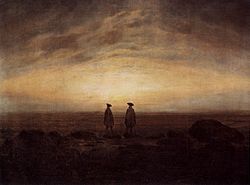In 1812 Mount Tambora, a volcano on the island of Sumbawa in the East Indies, one which had been dormant for centuries, began to rumble. For the next three years there were emissions from the volcano, but these were all eclipsed by its full-scale eruption on the 10th of April 1815. For the next three months it erupted violently in what is still the most powerful recorded volcanic eruption in history. So intense was the eruption that it altered global weather patterns for some time to come. The worst impact of this was felt in 1816, a year in which unusually cold weather prevailed and which has come to be known as ‘The year without a summer’. It remains the coldest summer on record in the northern hemisphere. The extreme weather caused crop failures across the world and the worst famine in Europe for decades. Owing to these events, large scale migrations of people occurred in various parts of the world.[1]
Chronology of eventsChronology of events
Sometimes volcanic eruptions can impact the whole world, such as in their effect on global weather patterns. One such case occurred in the 530s when it is believed that a volcanic winter took place worldwide following the eruption of a volcano somewhere, with scholars proposing various suspects, the most recent being the volcano in El Salvador which created Lake Ipolango there. Scholars have referred to the year 536 as ‘the worst year to be alive’ owing to the negative impact globally of the volcanic winter. But it has a close competitor in the shape of the year 1816, dubbed ‘The year without a summer’.[2]

The events of 1816 were triggered by the volcanic eruption of Mount Tambora on the island of Sumbawa in the East Indies around the central part of modern-day Indonesia. Tambora had not erupted for centuries and was believed to be completely dormant by many. But in 1812 rumbles and emissions began, gradually building until the volcano erupted violently in April 1815. For the next three months it went through the largest volcanic eruption in recorded history. The initial explosion on the 10th of April was heard on the island of Sumatra over 2,500 kilometers away, while the eruption eventually ejected over 10 billion tons of rock and debris. By the time it ended in mid-July Mount Tambora, which had risen to a peak of 4,300 meters prior to the eruption, stood just over 2,850 meters high. The eruption had literally blown nearly a kilometer and a half off of the top of the mountain. An estimated 10,000 people or more also lost their lives directly in the eruption.[3]
Influence on cultureInfluence on culture

The worst effects of the eruption of Mount Tambora were seen in 1816 as the impacts of the sheer amount of ash and debris which the volcano had emitted into the sky was felt. Such was the scale of the volcanic winter that it darkened the skies around the world and paintings such as Two Men by the Sea produced by artists like Caspar David Friedrich in the second half of the 1810s generally depict the sky in darker hues of grey and red, as it would have appeared in the context of a volcanic winter. Such was the gloom that pervaded society that cultural output in the west took on a notably darker tone. Mary Shelley wrote Frankenstein in the midst of it.
Resulting migrationResulting migration
The reduced sunlight caused by the volcanic event led to significantly lower temperatures, particularly in the northern hemisphere, as well as droughts. The summer of 1816 remains the coldest on record in the northern hemisphere which also led to significant crop failures, and with it famines.[4]As all of this occurred, people began leaving certain parts of some countries and moving towards others. One particular area of migration was from New England in the United States westwards towards regions like the west of New York State, Ohio and the southern shores of the Great Lakes in search of new opportunities.[5] The years 1816 and 1817 also saw tens of thousands of people migrate from the Rhineland region of western Germany down the River Rhine and board ships for the United States.[6] A seldom noted element of the migrations of 1816 is that this was the year in which the first freed slaves from the United States arrived in the region of western Africa, which would become Liberia under the auspices of the American Colonization Society in years to come.[7] There may also have been considerable migration in parts of the world such as China and Africa which remains unrecorded to a large extent.
Demographic impactDemographic impact
It is difficult to assess the precise impact of the events of 1816 on the demography of different countries. This is because a number of different impulses were leading people to migrate in 1816, the weather and agricultural impact of the eruption of Mount Tambora was just one factor. Taking the example of the New England migrants of the late 1810s, who were not only reacting to the weather events of 1816, but they were also spurred on by the opening up of the Great Lakes region following the end of the War of 1812 with Britain in 1815. Similarly, the tens of thousands of Rhineland migrants who left Germany in 1816 and 1817 were motivated by more than just 'The year without a summer’. Many were responding to the end of the Napoleonic Wars in 1815 and the fact that the Rhineland region was once more devolving into several independent German states, where since the mid-1790s much of it had been ruled as part of the French state and empire. Thus, while the eruption of Mount Tambora and the subsequent volcanic winter of 1816 encouraged migration in a lot of regions, it was not exclusively responsible for it.
See alsoSee also
Explore more about 1816: The year without a summerExplore more about 1816: The year without a summer
- Germany, Rhineland Emigrants, 1814-1939 record collection at MyHeritage
- New York Castle Garden Immigrants record collection at MyHeritage
- It Is Well With My Soul: Finding Ancestors Amid the Rubble of Disaster and Misfortune at Legacy Family Tree Webinars
References
- ↑ The Year Without a Summer: Mount Tambora Volcanic Eruption. The Old Farmer’s Almanac
- ↑ Why 536 was ‘the worst year to be alive'. Science Magazine
- ↑ Blast from the Past. Smithsonian Magazine
- ↑ How the year without summer gave us dark masterpieces. The Guardian
- ↑ Volcanoes, Weather, Food Shortages and Westward Migration. Norfolk Towne Assembly
- ↑ Boyd, James. THE RHINE EXODUS OF 1816/1817 WITHIN THE DEVELOPING GERMAN ATLANTIC WORLD. Cambridge University Press
- ↑ Founding of Liberia, 1847. Office of the Historian, Foreign Service Institute

